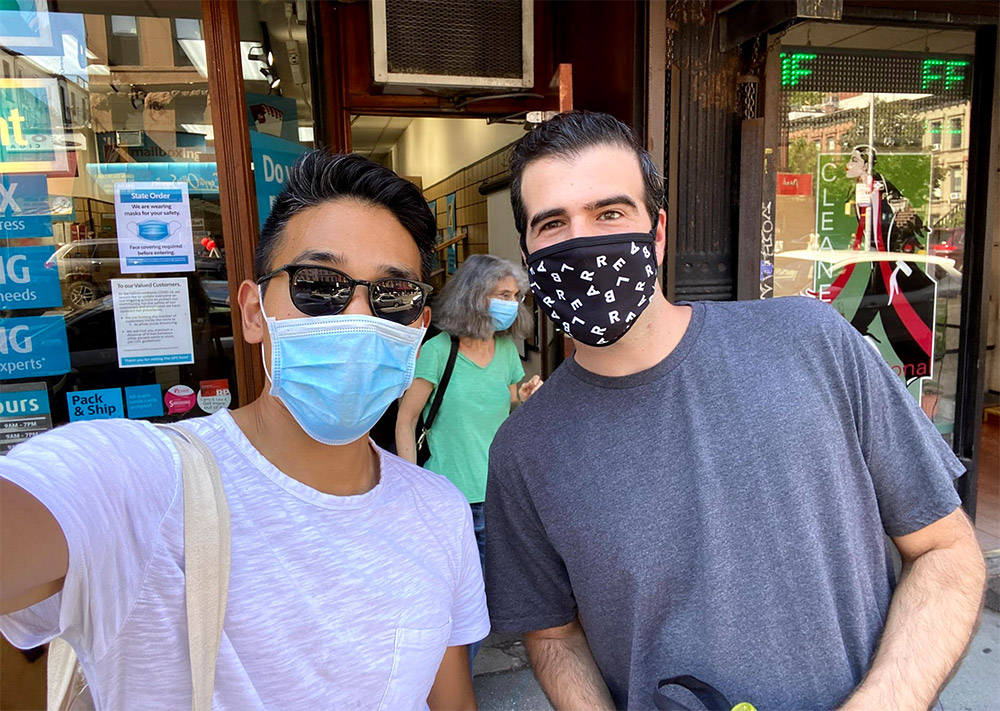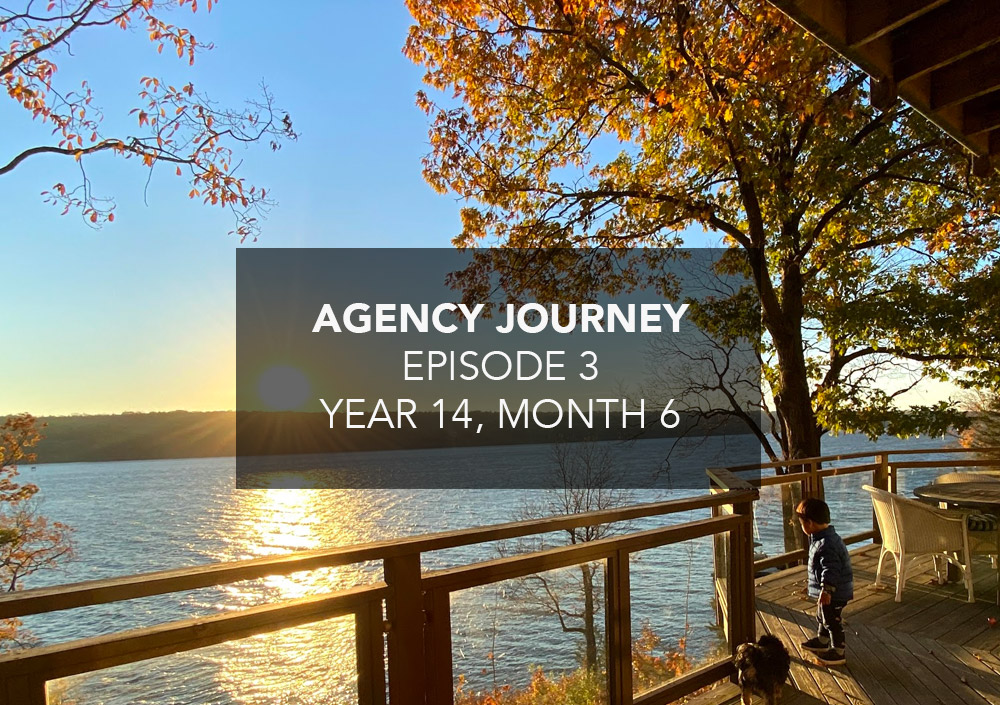The past four weeks haven’t been the smoothest of times. We’ve had some hiccups in delivering for our clients that’s led to frustration for our clients and scrambling on our end to make amends. New business activity has also been slower than we’d like, so our numbers aren’t looking great at the moment.
I trust that things will improve and we’ll find a way through these rough patches. What I’ve come to value more and more is how we handle these situations–the way we learn from our mistakes as a team, the way we handle ourselves during stressful moments (staying calm, being understanding of others, and being mindful not to overreact), and the way we keep our focus on the controllable vs. the uncontrollable.
This is not to say that I’m immune from having foul moods, venting, and sighing a bit too often. But my hope is to keep building the muscle so I can more quickly be aware of my conduct during challenging times and behave in ways I can respect in hindsight.
On to episode 3.
About Agency Journey: This is a monthly series detailing the happenings of my agency Barrel, founded in 2006. You can find previous episodes here.
Highlights
Director of Business Development
At our Q4 Town Hall in October, we announced the promotion of our Account Director Dan Fleishaker to the role of Director of Business Development.

A selfie with Dan during a rare in-person meet-up in Park Slope.
Dan joined us 2 years ago and has been a crucial player in helping the agency grow. He had initially been brought in to play a hybrid role of overseeing key accounts and also helping out on the new business front. We quickly found that Dan brought a high level of enthusiasm and positive energy to everything he did, motivating us to invest our time to transitioning more and more business development responsibilities over to him.
As Dan gained more experience qualifying clients, having key conversations, and closing deals, Sei-Wook and I, for the first time since we started Barrel, felt we could completely trust our new business efforts to Dan and let him run the show.
This had far-reaching impact. It allowed me and Sei-Wook to focus our energies on other parts of the business. Sei-Wook strengthened various aspects of our HR and finance functions as well as making key hires on the Production team. I was able to focus more time and energy on expanding our services offering and finding more ways to engage with brands. We had space to actually work on the company vs. trying to find cracks of time in-between new business calls.
As the Director of Business Development, Dan will work to scale up our new business efforts. Assisted by a Business Development Coordinator, Dan will look to refine the way we tell our story to new prospects, collaborate with different departments to strengthen case studies and other marketing materials, and work with subject matter experts to streamline the way we scope and put forward approaches to new opportunities.
One mistake I’ve made over and over in my career is the acceleration of the Peter Principle (no pun intended!) where I’ve promoted promising people way too fast and piled on them too many responsibilities without the necessary support and guidance, eventually leading them to a point where they perform poorly in their role. This has led to burnout, departures, and firings, all of which could have been avoided with more intentionality and better management.
I find Dan’s promotion particularly rewarding because we went about it the right way. We didn’t rush the learning process and worked closely day-in and day-out to the point where our intuitions and approaches synced up nicely. It helped that Dan was tireless in his efforts to continually improve and learn from each new experience. To see him confidently represent Barrel and land great clients is a testament to how talented people can wildly succeed when matched with a supportive environment.
Director of Client Services Hiring Continues
At one point last month, I was pretty certain we had our next Director of Client Services dialed in and ready to sign. However, after submitting our offer, the candidate decided to go in a different direction. This was a discouraging setback as I had come to be very excited about the prospect of this candidate joining the team.
Thankfully, the pace of business and life didn’t let me wallow in self-pity for too long, and I quickly moved on to vetting new candidates and taking on other pressing matters. I’m still hopeful that we’ll make a hire before the end of this year. In the meantime, I’ve been refining my thoughts on how this role and the Client Services discipline can sit within the org and interact with the other disciplines. This will be helpful when it comes time to onboard the new hire.
One thing I’ve noticed over and over again in my career: a setback is momentary and can actually be the start of a new opportunity. This is especially true if I’m able to take the setback as a learning experience and emerge from it even a tad bit wiser. In the case of this particular setback, I realized that I needed to tighten up the interview process in terms of timing and pace and to also look for candidates with more management/mentorship experience. I’m looking forward to seeing how this all plays out.
Taking Time Off
Back in July, my wife Melanie was offered her sister’s beach house in Delaware thanks to a last-minute booking cancelation. I had my hesitation about going down that week because it was the start of a new quarter and that week in particular was booked fully with various planning meetings and time-sensitive deadlines. We decided to give it a go and told ourselves that we would work during the day and hang out in the mornings and evenings.
I joke that this was perhaps one of the worst weeks of the year for me. I was grateful to be staying at a comfortable beach house just a couple minutes from the beach with access to a beautiful park around the corner. However, the combination a softer-than-usual bed, less sleep due to our toddler having trouble sleeping, and one of the busiest work weeks on my calendar all conspired to make me irritated, uncomfortable, and stressed out. I vowed never to leave home unless I was truly off from work.

Immersing myself in spaces like this helped to clear my head and gain better perspective on life and business.
After Election Night, we took our first true family vacation of 2020. We took a few days off to stay on the Hudson River in Saugherties. It was a spacious home with a great view. While we may have checked our phones one too many times to get the lates on post-election results, we were happy to be off from work. We spent large chunks of the day going on hikes, dining outdoors, and finding creeks for our son to throw rocks. I even found time to read some fiction.
In general, I came away from the vacation believing that I was doing myself a disservice by not taking more time off. I find that work has a gravitational pull to it, continually pulling me deeper and deeper into the day-to-day and making me more attuned to looking out for and solving the immediate problems. What vacations help do is to pull me out of the day-to-day momentarily, long enough for me to take a step back and take stock of things. It was during our drives and my solo jogs in the countryside where I found some quiet time to ask myself if I was focused on the right things, what I needed to care about in the long term, and what structural challenges I may face in the coming years. These are incredibly valuable moments that produce new insights and unleash creativity. More on this below where I talk about the 80/20 principle.
On a tangentially related note, Wesley, our Director of Technology and one of the partners, and his wife Jamela gave birth to a baby daughter recently. I’m super happy for them. Wes is currently on parental leave, and I was reminded of my own time away in early 2019 when our son was born. While it was no vacation in terms of having a leisurely time, the long period away from work had some positive impact. I ended up reading a lot of random books, trying my hand at creative writing when the baby was napping, and thinking about long-term prospects of Barrel including what was and wasn’t working. When I came back to work, I felt much lighter and more energized from having had the time to think and ponder the entire forest after so many years zeroed-in on the trees. Hope Wes can enjoy and make the most of his quiet moments as well.
Top of Mind
80/20 Principle and Managing My Time & Priorities
“What is the 80/20 Principle? It is the observation that a small number of events give rise to the majority of effects. Most consequences come from few causes. The great majority of outputs come from a small minority of inputs. The lion’s share of results comes from a small amount of effort and energy.” (Richard Koch, The 80/20 Manager)
The 80/20 principle, also known as the Pareto principle, comes up quite often in business. 20% of clients contribute to 80% of profits. The top 20% of employees generate 80% of value for the company. There are so many different places where you see this pattern playing out. Of course, it’s not about an accurate or perfect 80/20 numerical breakdown but the more general idea that the “majority of outputs come from a small minority of inputs”.
I’ve been wondering about the 80/20 principle when applied to my personal inputs at work. What are my 20% inputs that generate 80% outputs for Barrel? Where is the source of leverage? And conversely, where am I spending the majority of my time and not getting much out of it?
The answer to the first question is in the next section. As to where I’ve been spending the majority of my time and not producing much, I realized they were mostly routine check-in meetings as well as random time slots that usually got used for checking and responding to emails.
Upon coming back from my vacation, I decided to do a calendar purge and revisited every one of the recurring meetings on my calendar. As an initial step, I turned most of my check-in type meetings from weekly meetings to biweekly ones with an eye towards phasing out some of them. I also moved some existing meetings around to open up larger 2-3 hour chunks for me to do deeper work. I found that 1-hour time slots rarely give me the space to go deep into anything.
The goal for me is to bring more intention to these 2-3 hour chunks each week, devoting them to the types of work that I share in the next section.
Vision, Intentions, and Questions
I wrote a memo to the Partners one evening when I was feeling particularly hot about defining our 20% high-leverage activities. Here’s an excerpt:
The 20 percent high-leverage activity for us as leaders from here on out is to set (and continually repeat) a clear vision for the team leads* and help them set their intentions through thought-provoking and challenging questions. Then it’s all about giving the team leads the space to self-organize and make progress. The rest of the lower leverage work is providing support, encouragement, and on-going coaching.
*This is assuming that we have the right team leads in place. If this is not the case, the 20 percent high-leverage activity needs to first be in recruiting and hiring this person.
My thinking around this is that if the Barrel partners focus our time in building vision alignment with team leaders–people who either have their own direct reports or exercise influence within the org–and build the habit of tying actions to achieving the shared vision, this would cut down on wasteful, incoherent initiatives while giving plenty of room for people to be creative in their approaches.
To put it more simply, the 20% high-leverage activities boil down to:
- Setting and reinforcing vision
- Recruiting & hiring the best people
When put this way, there’s so much work to do in both areas. I don’t think we’ve been great about articulating and consistently communicating the company’s vision. We also know that vision is not just a lofty company-wide statement but can live as more focused discipline-specific objectives and business-driven goals. These need to be defined, shared, internalized, and continually revisited. The same goes for recruiting. Rather than reactively seeking to fill roles as they come up, I hope to push Barrel towards continually coming in contact with the best and the brightest, staying in touch, and being able to find ways to work together when the time is right. This means investing more in the recruitment infrastructure and being willing to hire not for immediate billable needs but for future growth.
Assuming that 20% of our work week is around 6-8 hours, how close do we come to filling that time with the activities above? In my own case, the sad truth is that my calendar does not reflect what I believe to be the most important activities for the business. Too much time, as mentioned above, is spent on checking in and keeping up with my emails–activities that are gateways to getting involved with in-the-weeds troubleshooting and needless meddling (e.g. “it shouldn’t be done this way!”).
Taking control of my calendar and being vigilant of the inevitable entropy will be an important habit for me to cultivate. Every week needs to be approached with the goal of hitting those 6-8 hours of quality 20% activities.
Side note: nothing here is new but it’s one thing to recognize how things should be and another to make it happen. I revisited Peter Drucker’s lessons on time management in The Effective Executive, which I’ve also written about in the past.
Shared with Partners
“Your actions reveal how badly you want something. If you keep saying something is a priority but you never act on it, then you don’t really want it. It’s time to have an honest conversation with yourself. Your actions reveal your true motivations.” (James Clear, Atomic Habits)
This was an apt quote especially when thinking about the 80/20 principle and the need to get my calendar to reflect the high-leverage activities I know I should be doing more of.
“But when you think of the company as a product, you ask different questions: Do people who work here know how to use the company? Is it simple? Complex? Is it obvious how it works? What’s fast about it? What’s slow about it? Are there bugs? What’s broken that we can fix quickly and what’s going to take a long time?” (Jason Fried, David Heinemeier Hansson, It Doesn’t Have to Be Crazy at Work)
This is a great thought exercise–to imagine your company as a product–because it gives you a lens through which to quickly highlight strengths, weaknesses, structural characteristics, and user experience. When I put Barrel through this lens, I see a number of good things but also a number of areas where we are struggling such as knowledge management, predictability (in sales), and speed in certain types of activities.
